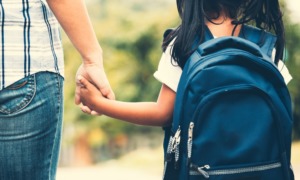Two teens are dead and 18 are wounded in more school shootings, this time in surburban San Diego. The carnage revealed some dismaying adjustments that are underway in American society. The media and political classes are apparently suffering from “school shooting fatigue.” The Santee shooting was only a two-day front-page story, apparently because the 15-year-old shooter failed to surpass the Columbine High School body count of 15. Even on the day of the shooting, a routine heart procedure for Vice President Dick Cheney won the “if it bleeds, it leads” competition on the evening news.
Our political leaders, meanwhile, are so fatigued over the circulation of 65 million handguns that the gun used by 15-year-old Andy Williams rated barely a mention. President Bush said, in effect, it was a sad occurrence. House Minority Leader Richard Gephardt’s statement – “As just the latest shooting in America, this is a tragedy for the entire nation” – was stronger but, like Bush, he refrained from mentioning gun control legislation that has stymied the reauthorization of the Juvenile Justice Act.
Today’s compassion fatigue is rooted in the perceived futility of preventing more rampage killings in a nation bursting with 200 million firearms. Can anything short of banning handguns work?
Santana High School had in place an arsenal of anti-violence strategies. The school had a thorough emergency plan, and school security officers provided what security types call “target hardening,” including an upgraded communications system. What was left over from Santana High School’s $86,000 share of the school district’s $1.1 million grant last year from the U.S. Justice Department’s Community Oriented Policing Services (COPS) program went for a single school counselor for its 1,900 students. A new conflict resolution program called the Peace Council was up and running. “We were prepared to respond,” said Santana Principal Karen Degiescher. So, too, was neighboring Granite Hills High School.
While further restricting the supply and access to guns is the single most promising remedy, it is, for now, politically unobtainable. More cops in schools, metal detectors and often vapid “just say no” anti-violence and drug abuse classroom education are not promising solutions. In the past two years the COPS program has spent $350 million to fund about 3,200 cops in the schools at an annual cost of $54,687 each. In addition to the COPS funding, another federal program, Safe and Drug-Free Schools, will spend $644 million this year. Equally unpromising is more federal spending on national groups providing training and technical assistance to schools, police and youth-serving agencies.
At a pre-Columbine National Summit on School Violence in September 1998, Minneapolis Police Chief Robert Olson suggested that the nation put 100,000 youth workers in the schools to help troubled kids before they hurt someone. A few weeks later, even President Clinton endorsed the idea. But the call for real youth workers in the schools (not what teens call “narcs”) was quickly quashed by the jobs-for-us education, mental health and law enforcement special interests.
In a recent ABC News poll of high school students, one in 10 said they have heard of a plan to shoot or kill fellow students. Research by the U.S. Secret Service and others has revealed that about 75 percent of kid shooters told one or more persons of their catastrophic plans. Most told their peers, who were reluctant to snitch on one of their own, especially given today’s “zero tolerance” hysteria.
Now consider if every one of the nation’s 20,997 public secondary schools had just two trained youth workers employed by (and only reporting to) a credible outside youth-serving agency. It is quite plausible that few of these lethal secrets would have remained so. For the same price as a single cop, two skilled, detached youth workers could focus on building strong personal relationships with the most alienated and marginalized youth.
Youth work, with its emphasis on building strong, trusting relationships, offers the best chance of breaking through the adolescent code of silence. Properly trained and supported, a team of youth workers each earning around $30,000 would cost the nation $1.25 billion annually, or about the same as is now spent by COPS, Safe and Drug-Free Schools and other directly related federal safe schools programs. Expensive? Compare that to the more than $100,000 annual cost to train, pay and provide support for one full-time DARE police officer. Putting youth workers in schools and communities is a bargain waiting for a buyer.































